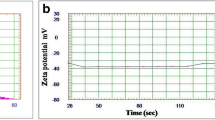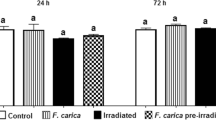Abstract
The main purpose of this study was to investigate the protective effect of Rosmarinus officinalis, Origanum compactum, Lavandula angustifolia, and Eucalyptus globulus essential oils (EOs) against gamma-radiation-induced damages on Tetrahymena pyriformis growing in presence of cobalt-60 source. The chemical composition of the 4 EOs was analyzed by gas chromatography–mass spectrometry. The protective effects of EOs on growth, on morphology, and on some metabolic enzymes and antioxidant markers have been evaluated. Thus, addition of EOs significantly improves the growth parameters (generation number and time) in irradiating conditions. All EOs allowed restoring growth parameters over more than 90% compared to the controls. The morphological analysis indicated that T. pyriformis cells growing in irradiating conditions were able to regain their normal form in presence of the different EOs. Our results indicate that the 4 EOs also have protective effects on some metabolic enzymes. They allowed recovering totally or partially the glyceraldehyde 3-phosphate dehydrogenase and the succinate dehydrogenase activities compared to the controls. Moreover, the addition of EOs reduced the lipid peroxidation level and decreased the activities of catalase and superoxide dismutase induced by the gamma-radiation exposure. A more pronounced protective effect was found for O. compactum and L. angustifolia EOs compared to R. officinalis and E. globulus EOs. These results suggest that the studied EOs are efficient natural antioxidants that could offer protection against gamma-radiation-induced damages and can therefore be useful in clinical medicine.




Similar content being viewed by others
Data Availability
Not applicable.
Code Availability
Not applicable.
References
Hayashi T (1991) Comparative effectiveness of gamma-rays and electron beams in food irradiation. In: Thorne S (ed) Food irradiation. Elsevier, London, pp 169–206
Silindir M, Özer AY (2009) Sterilization methods and the comparison of e-beam sterilization with gamma radiation sterilization. FABAD J Pharm Sci 34:43–53
Hosseinimehr SJ (2007) Trends in the development of radioprotective agents. Drug Discov Today 12:794–805. https://doi.org/10.1016/j.drudis.2007.07.017
Ewing D, Jones SR (1987) Superoxide removal and radiation protection in bacteria. Arch Biochem Biophys 254(1):53–62. https://doi.org/10.1016/0003-9861(87)90080-4
Cerutti PA (1985) Prooxidant states and tumor promotion. Science 227(4685):375–381. https://doi.org/10.1126/science.2981433
Prasad NR, Menon VP, Vasudev V, Pugalendi KV (2005) Radioprotective effect of sesamol on g-radiation induced DNA damage, lipid peroxidation and antioxidants level in cultured human lymphocytes. Toxicology 209(3):225–235. https://doi.org/10.1016/j.tox.2004.12.009
Ziyadi S, Iddar A, Kabine M, El Mzibri M, Moutaouakkil A (2022) Changes in growth, morphology, and physiology of Tetrahymena pyriformis exposed to continuous Cesium-137 and Cobalt-60 gamma-radiation. Curr Microbiol 79(2):61. https://doi.org/10.1007/s00284-021-02684-6
Fourrat L, Iddar A, Valverde F, Serrano A, Soukri A (2007) Effects of oxidative and nitrosative stress on Tetrahymena pyriformis glyceraldehyde-3-phosphate dehydrogenase. J Eukaryot Microbiol 54(4):338–346. https://doi.org/10.1111/j.1550-7408.2007.00275.x
Mountassif D, Kabine M, Manar R, Bourhim N, Zaroual Z, Latruffe N, El Kebbaj MS (2007) Physiological, morphological and metabolic changes in Tetrahymena pyriformis for the in vivo cytotoxicity assessment of metallic pollution: Impact on D-β-hydroxybutyrate dehydrogenase. Ecol Indic 7(4):882–894. https://doi.org/10.1016/j.ecolind.2006.11.010
Henry E, Fung N, Liu J, Drakakaki G, Coaker G (2015) Beyond glycolysis: GAPDHs are multi-functional enzymes involved in regulation of ROS, autophagy, and plant immune responses. PLOS Genet 11(4):e1005199. https://doi.org/10.1371/journal.pgen.1005199
Patt HM, Tyree EB, Straube RL, Smith DE (1949) Cysteine protection against X irradiation. Science 110(2852):213–214. https://doi.org/10.1126/science.110.2852.213
Maurya DK, Devasagayam TPA, Nair CKK (2006) Some novel approaches for radioprotection and the beneficial effect of natural products. Indian J Exp Biol 44(2):93–114
Kordali S, Cakir A, Ozer H, Cakmakci R, Kesdek M, Mete E (2008) Antifungal, phytotoxic and insecticidal properties of essential oil isolated from Turkish Origanum acutidens and its three components, carvacrol, thymol and p-cymene. Bioresour Technol 99:878895. https://doi.org/10.1016/j.biortech.2008.04.048
Cowan MM (1999) Plant products as antimicrobial agents. Clin Microbiol Rev 12(4):564–582. https://doi.org/10.1128/cmr.12.4.564
Greathead H (2003) Plants and plant extracts for improving animal productivity. Proc Nutr Soc 62(2):279–290. https://doi.org/10.1079/pns2002197
Jagetia GC, Baliga MS (2002) Influence of the leaf extract of Mentha arvensis Linn. (mint) on the survival of mice exposed to different doses of gamma radiation. Strahlenther Onkol 178:91–98. https://doi.org/10.1007/s00066-002-0841-y
Bouyahya A, Abrini J, Dakka N, Bakri Y (2019) Essential oils of Origanum compactum increase membrane permeability, disturb cell membrane integrity, and suppress quorum-sensing phenotype in bacteria. J Pharm Anal 9(5):301–311. https://doi.org/10.1016/j.jpha.2019.03.001
Nieto G, Ros G, Castillo J (2018) Antioxidant and antimicrobial properties of rosemary (Rosmarinus officinalis L.): a review. Medicines (Basel) 5(3):98. https://doi.org/10.3390/medicines5030098
Hafsa J, Smach MA, Ben Khedher MR, Charfeddine B, Limem K, Majdoub H, Rouatbi S (2016) Physical, antioxidant and antimicrobial properties of chitosan films containing Eucalyptus globulus essential oil. LWT Food Sci Technol 68:356–364. https://doi.org/10.1016/j.lwt.2015.12.050
Hajhashemi V, Ghannadi A, Sharif B (2003) Anti-inflammatory and analgesic properties of the leaf extracts and essential oil of Lavandula angustifolia Mill. J Ethnopharmacol 89(1):67–71. https://doi.org/10.1016/s0378-8741(03)00234-4
Adams RP (2007) Identification of essential oil components by gas chromatography/mass spectroscopy, 4th edn. Allured Publ, Carol Stream, p 804
Pousada CR, Cyrne ML, Hayes D (1979) Characterization of preribosomal ribonucleoprotein particles from Tetrahymena pyriformis. Eur J Biochem 102(2):389–397. https://doi.org/10.1111/j.1432-1033.1979.tb04254.x
Bradford M (1976) A rapid and sensitive method for the quantitation of microgram quantities of protein utilizing the principle of protein dye binding. Anal Biochem 72(1–2):248–254. https://doi.org/10.1006/abio.1976.9999
Iddar A, Serrano A, Soukri A (2002) A phosphate-stimulated NAD(P)+-dependent glyceraldehyde-3-phosphate dehydrogenase in Bacillus cereus. FEMS Microbiol Lett 211(1):29–35. https://doi.org/10.1111/j.1574-6968.2002.tb11199.x
King TE (1967) Preparation of succinate cytochrome c reductase and cytochrome b-cl particles and reconstitution of succinate-cytochrome c reductase. In: Estabrook R (ed) Methods in enzymology. Academic Press, Tokyo, pp 216–225
Samokyszyn VM, Marnett LJ (1990) Inhibition of liver microsomal lipid peroxidation by 13-cis-retinoic acid. Free Radic Biol Med 8(5):491–496. https://doi.org/10.1016/0891-5849(90)90063-o
Aebi H (1984) Catalase in vitro. Methods Enzymol 105:121–126. https://doi.org/10.1016/S0076-6879(84)05016-3
Paoletti F, Aldinucci D, Mocali A, Caparrini A (1986) A sensitive spectrophotometric method for the determination of superoxide dismutase activity in tissue extracts. Anal Biochem 154(2):536–541. https://doi.org/10.1016/0003-2697(86)90026-6
Dias N, Mortara RA, Lima N (2003) Morphological and physiological changes in Tetrahymena pyriformis for the in vitro cytotoxicity assessment of triton X-100. Toxicol In Vitro 17(3):357–366. https://doi.org/10.1016/s0887-2333(03)00023-7
Halliwell B, Gutteridge JM (1990) Role of free radicals and catalytic metal ions in human disease: an overview. Methods Enzymol 186:1–85. https://doi.org/10.1016/0076-6879(90)86093-b
Arora R, Gupta D, Chawla R, Sagar R, Sharma A, Kumar R, Prasad J, Singh S, Samanta N, Sharma RK (2005) Radioprotection by plant products: present status and future prospects. Phytother Res 19(1):1–22. https://doi.org/10.1002/ptr.1605
Kumar M, Prakash S, Radha KN, Pundir A, Punia S, Saurabh V, Choudhary P, Changan S, Dhumal S, Pradhan PC, Alajil O, Singh S, Sharma N, Ilakiya T, Singh S, Mekhemar M (2021) Beneficial role of antioxidant secondary metabolites from medicinal plants in maintaining oral health. Antioxidants (Basel) 10(7):1061. https://doi.org/10.3390/antiox10071061
Ivanova T, Han Y, Son HJ, Yun YS, Song JY (2006) Antimutagenic effect of polysaccharide ginsan extracted from Panax ginseng. Food Chem Toxicol 44(4):517–521. https://doi.org/10.1016/j.fct.2005.08.032
Samarth RM, Samarth M, Matsumoto Y (2017) Medicinally important aromatic plants with radioprotective activity. Future Sci OA. https://doi.org/10.4155/fsoa-2017-0061
Cimanga K, Kambu K, Tona L, Apers S, De Bruyne T, Hermans N, Totté J, Pieters L, Vlietinck AJ (2002) Correlation between chemical composition and antibacterial activity of essential oils of some aromatic medicinal plants growing in the Democratic Republic of Congo. J Ethnopharmacol 79(2):213–220. https://doi.org/10.1016/s0378-8741(01)00384-1
Abd-ElGawad AM, El Gendy AE-NG, Assaeed AM, Al-Rowaily SL, Alharthi AS, Mohamed TA, Nassar MI, Dewir YH, Elshamy AI (2021) Phytotoxic effects of plant essential oils: a systematic review and structure-activity relationship based on chemometric analyses. Plants (Basel) 10(1):36. https://doi.org/10.3390/plants10010036
Di Pasqua R, Hoskins N, Betts G, Mauriello G (2006) Changes in membrane fatty acids composition of microbial cells induced by addiction of thymol, carvacrol, limonene, cinnamaldehyde, and eugenol in the growing media. J Agric Food Chem 54(7):2745–2749. https://doi.org/10.1021/jf052722l
Turina AV, Nolan MV, Zygadlo JA, Perillo MA (2006) Natural terpenes: self-assembly and membrane partitioning. Biophys Chem 122(2):10–113. https://doi.org/10.1016/j.bpc.2006.02.007
Mojica ERE, Deocaris CC, Endriga MA (2004) Essential oils with anti-protozoal activities. Philipp J Crop Sci 29(3):41–43
Mar PD, El Khalfi B, Soukri A (2020) Protective effect of oregano and sage essentials oils against the effect of extracellular H2O2 and SNP in Tetrahymena thermophila and Tetrahymena pyriformis. J King Saud Univ - Sci 32(1):279–287. https://doi.org/10.1016/j.jksus.2018.05.005
Errafiy N, Ammar E, Soukri A (2013) Protective effect of some essential oils against oxidative and nitrosative stress on Tetrahymena thermophila growth. J Essent Oil Res 25:339–347. https://doi.org/10.1080/10412905.2013.775681
Schieber M, Chandel NS (2014) ROS function in redox signaling and oxidative stress. Curr Biol 24(10):R453–R462. https://doi.org/10.1016/j.cub.2014.03.034
Ding HY, Chou TH, Liang CH (2010) Antioxidant and antimelanogenic properties of rosmarinic acid methyl ester from Origanum vulgare. Food Chem 123(2):254–262. https://doi.org/10.1016/j.foodchem.2010.04.025
Karamalakova Y, Sharma J, Nikolova G, Stanev S, Arora R, Gadjeva V, Zheleva A (2013) Studies on antioxidant properties before and after UV- and γ-irradiation of Bulgarian lavender essential oil isolated from Lavandula angostifolia Mill. Biotechnol Biotechnol Equip 27(3):3861–3865. https://doi.org/10.5504/BBEQ.2012.0138
Adnan M (2019) Bioactive potential of essential oil extracted from the leaves of Eucalyptus globulus (Myrtaceae). J Pharmacogn Phytochem 8(1):213–216
Ridaoui K, Guenaou I, Taouam I, Cherki M, Bourhim N, Elamrani A, Kabine M (2022) Comparative study of the antioxidant activity of the essential oils of five plants against the H2O2 induced stress in Saccharomyces cerevisiae. Saudi J Biol Sci 29(3):1842–1852. https://doi.org/10.1016/j.sjbs.2021.10.040
Acknowledgements
The authors would like to thank Dr. Moussaif A, Dr. Sbihi Y, Dr. Bouayyadi A, Mr Amaarof M, Mr Moulahid H and Mrs Bellemjid N (CNESTEN, Rabat, Morocco) for their assistance and helpful suggestions.
Funding
This work was supported by the National Center for Nuclear Energy, Science and Technology (CNESTEN) as an internal project grant.
Author information
Authors and Affiliations
Contributions
Conceptualization: [AI, AM]; Methodology: [SZ, AI, NE, AM]; Formal analysis and investigation: [SZ, NE, KR, MK, AM]; Writing-original draft preparation: [AI, AM]; Writing-review and editing: [AI, AM]; Funding acquisition: [ME]; Supervision: [ME, AM]. All authors read and approved the final version of the manuscript.
Corresponding author
Ethics declarations
Conflict of interest
The authors declare that they have no conflicts of interest.
Ethics Approval
Not applicable.
Consent to Participate
Not applicable.
Consent for Publication
Not applicable.
Additional information
Publisher's Note
Springer Nature remains neutral with regard to jurisdictional claims in published maps and institutional affiliations.
Supplementary Information
Below is the link to the electronic supplementary material.
Rights and permissions
Springer Nature or its licensor holds exclusive rights to this article under a publishing agreement with the author(s) or other rightsholder(s); author self-archiving of the accepted manuscript version of this article is solely governed by the terms of such publishing agreement and applicable law.
About this article
Cite this article
Ziyadi, S., Iddar, A., Errafiy, N. et al. Protective Effect of Some Essential Oils Against Gamma-Radiation Damages in Tetrahymena pyriformis Exposed to Cobalt-60 Source. Curr Microbiol 79, 279 (2022). https://doi.org/10.1007/s00284-022-02924-3
Received:
Accepted:
Published:
DOI: https://doi.org/10.1007/s00284-022-02924-3




